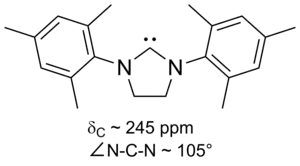 | |
| Names | |
|---|---|
| Preferred IUPAC name
Imidazolidin-2-ylidene | |
| Identifiers | |
3D model (JSmol) |
|
| ChemSpider | |
PubChem CID |
|
| |
| |
| Properties | |
| C3H6N2 | |
| Molar mass | 70.095 g·mol−1 |
Except where otherwise noted, data are given for materials in their standard state (at 25 °C [77 °F], 100 kPa).
Infobox references | |
Dihydroimidazol-2-ylidene is a hypothetical organic compound with formula C3H6N2. It would be a heterocyclic compound, formally derived from imidazolidine with two hydrogen atoms removed from carbon number 2, leaving two vacant chemical bonds — which makes it a carbene.
Although carbenes in general are extremely short-lived, some derivatives of this compound are surprisingly stable, and form an important class of the persistent carbenes. They include the first stable carbenes postulated (but not isolated) by Hans-Werner Wanzlick around 1960.[1][2][3]

Wanzlick's mechanism for the reaction of dihydroimidazol-2-ylidene with electrophiles

1,3-Dimesityl-imidazol-4,5-dihydro-2-ylidene, a stable carbene without delocalization around the ring containing the carbenic carbon
(external viewer)
(external viewer)
They also include an example of the (saturated) imidazolin-2-ylidene (carbene) reported by A.J. Arduengo in 1995.[4]
References
- ↑ H.-W. Wanzlick and E. Schikora (1960). "Ein neuer Zugang zur Carben-Chemie". Angewandte Chemie. 72 (14): 494. Bibcode:1960AngCh..72..494W. doi:10.1002/ange.19600721409.
- ↑ Hans-Werner Wanzlick and E. Schikora (1960). "Ein nucleophiles Carben". Chemische Berichte. 94 (9): 2389–2393. doi:10.1002/cber.19610940905.
- ↑ H.-W. Wanzlick (1962). "Aspects of Nucleophilic Carbene Chemistry". Angew. Chem. Int. Ed. Engl. 1 (2): 75–80. doi:10.1002/anie.196200751.
- ↑ A. J. Arduengo, III, H. V. R. Dias, R. L. Harlow, and M. Kline (1992). "Electronic stabilization of nucleophilic carbenes". J. Am. Chem. Soc. 114 (14): 5530–5534. doi:10.1021/ja00040a007.
{{cite journal}}: CS1 maint: multiple names: authors list (link)
This article is issued from Wikipedia. The text is licensed under Creative Commons - Attribution - Sharealike. Additional terms may apply for the media files.